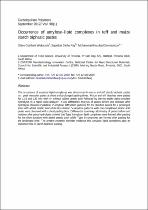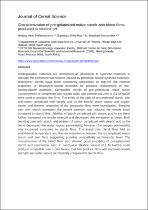 ResearchSpace
ResearchSpace
Isolation and characterisation of nanoparticles from tef and maize starch modified with stearic acid
JavaScript is disabled for your browser. Some features of this site may not work without it.
- ResearchSpace
- →
- Research Publications/Outputs
- →
- Journal Articles
- →
- View Item
| dc.contributor.author |
Cuthbert, WO

|
|
| dc.contributor.author |
Ray, Suprakas S

|
|
| dc.contributor.author |
Emmambux, NM

|
|
| dc.date.accessioned | 2018-05-15T10:45:06Z | |
| dc.date.available | 2018-05-15T10:45:06Z | |
| dc.date.issued | 2017-07 | |
| dc.identifier.citation | Cuthbert, W.O., Ray, S.S. and Emmambux, N.M. 2017. Isolation and characterisation of nanoparticles from tef and maize starch modified with stearic acid. Carbohydrate Polymers, vol 168, pp 86-93 | en_US |
| dc.identifier.issn | 0144-8617 | |
| dc.identifier.uri | https://www.sciencedirect.com/science/article/pii/S0144861717303314 | |
| dc.identifier.uri | http://hdl.handle.net/10204/10209 | |
| dc.description | Copyright: 2017 Elsevier. Due to copyright restrictions, the attached PDF file only contains the abstract of the full text item. For access to the full text item, please consult the publisher's website. The definitive version of the work is published in Carbohydrate Polymers, vol 168, pp 86-93 | en_US |
| dc.description.abstract | Nanoparticles were isolated from tef and maize starch modified with added stearic acid after pasting at 90 °C for 130 min. This was followed by thermo-stable alpha-amylase hydrolysis of the paste. The resultant residues were then characterized using X-ray diffraction (XRD), differential scanning calorimetry (DSC), dynamic laser scattering particle size distribution (DLPSD), atomic force microscopy (AFM) and high-resolution transmission electron microscopy (HRTEM). XRD and DSC showed that the isolated residues consisted of amylose-lipid complexes. These complexes were type II with melting temperature above 104 °C. DLPSD, AFM and HRTEM showed that the isolated tef and maize starch residues consisted of nanoparticles which became more distinct with increased hydrolysis time. The isolated tef and maize nanoparticles had distinct particles of about 3–10 nm and 2.4–6.7 nm, respectively and the yield was about 24–30%. The results demonstrated that distinct (physically separate) nanoparticles of less than 10 nm can be isolated after formation during pasting of tef and maize starch with stearic acid. The production and isolation of the nanoparticles uses green chemistry principles and these nanoparticles can be used in food and non-food systems as nanofillers. | en_US |
| dc.language.iso | en | en_US |
| dc.publisher | Elsevier | en_US |
| dc.relation.ispartofseries | Workflow;20227 | |
| dc.subject | Amylose lipid complexes | en_US |
| dc.subject | Maize starch | en_US |
| dc.subject | Starch hydrolysis | en_US |
| dc.subject | Starch nanoparticles | en_US |
| dc.subject | Teff starch | en_US |
| dc.subject | V-amylose | en_US |
| dc.title | Isolation and characterisation of nanoparticles from tef and maize starch modified with stearic acid | en_US |
| dc.type | Article | en_US |
| dc.identifier.apacitation | Cuthbert, W., Ray, S. S., & Emmambux, N. (2017). Isolation and characterisation of nanoparticles from tef and maize starch modified with stearic acid. http://hdl.handle.net/10204/10209 | en_ZA |
| dc.identifier.chicagocitation | Cuthbert, WO, Suprakas S Ray, and NM Emmambux "Isolation and characterisation of nanoparticles from tef and maize starch modified with stearic acid." (2017) http://hdl.handle.net/10204/10209 | en_ZA |
| dc.identifier.vancouvercitation | Cuthbert W, Ray SS, Emmambux N. Isolation and characterisation of nanoparticles from tef and maize starch modified with stearic acid. 2017; http://hdl.handle.net/10204/10209. | en_ZA |
| dc.identifier.ris | TY - Article AU - Cuthbert, WO AU - Ray, Suprakas S AU - Emmambux, NM AB - Nanoparticles were isolated from tef and maize starch modified with added stearic acid after pasting at 90 °C for 130 min. This was followed by thermo-stable alpha-amylase hydrolysis of the paste. The resultant residues were then characterized using X-ray diffraction (XRD), differential scanning calorimetry (DSC), dynamic laser scattering particle size distribution (DLPSD), atomic force microscopy (AFM) and high-resolution transmission electron microscopy (HRTEM). XRD and DSC showed that the isolated residues consisted of amylose-lipid complexes. These complexes were type II with melting temperature above 104 °C. DLPSD, AFM and HRTEM showed that the isolated tef and maize starch residues consisted of nanoparticles which became more distinct with increased hydrolysis time. The isolated tef and maize nanoparticles had distinct particles of about 3–10 nm and 2.4–6.7 nm, respectively and the yield was about 24–30%. The results demonstrated that distinct (physically separate) nanoparticles of less than 10 nm can be isolated after formation during pasting of tef and maize starch with stearic acid. The production and isolation of the nanoparticles uses green chemistry principles and these nanoparticles can be used in food and non-food systems as nanofillers. DA - 2017-07 DB - ResearchSpace DP - CSIR KW - Amylose lipid complexes KW - Maize starch KW - Starch hydrolysis KW - Starch nanoparticles KW - Teff starch KW - V-amylose LK - https://researchspace.csir.co.za PY - 2017 SM - 0144-8617 T1 - Isolation and characterisation of nanoparticles from tef and maize starch modified with stearic acid TI - Isolation and characterisation of nanoparticles from tef and maize starch modified with stearic acid UR - http://hdl.handle.net/10204/10209 ER - | en_ZA |








